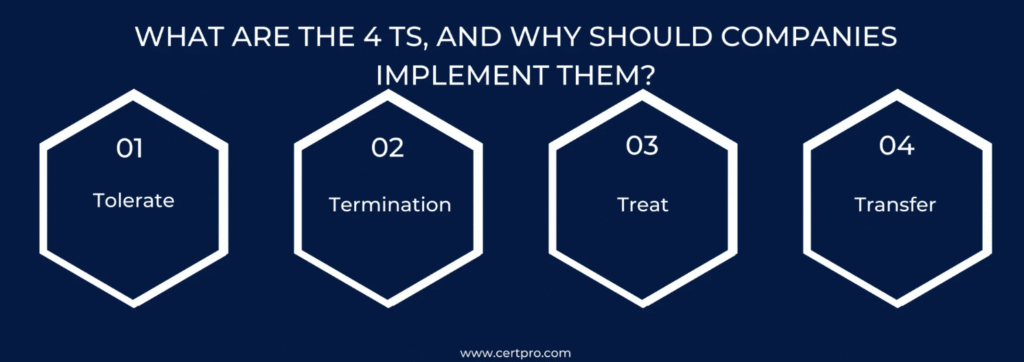4 T’s of Risk Management: Effective Strategies for Business Success
In today’s ever-changing business landscape, risk management is not just a compliance exercise—it’s a critical strategy for sustainability and long-term success. Whether it’s cybersecurity, operational disruption, or financial instability, understanding and managing risks can protect your organization from significant losses. One powerful method to approach this is through the 4 T’s of Risk Management: Tolerate, Treat, Transfer, and Terminate.
Let’s explore how each of these risk response strategies helps build a proactive and resilient risk management framework.
What Is Risk Management and Why Is It Important?
Risk management is the process of identifying, assessing, and responding to potential threats that can negatively impact a business. These threats can come from a wide range of sources—cybersecurity breaches, market volatility, legal liabilities, operational failures, or even natural disasters.
By understanding risks early, businesses can make informed decisions, protect their assets, and ensure continuity. It’s not just about avoiding negative events; it’s about preparing for them, minimizing impact, and staying compliant with industry standards like ISO 31000, SOC 2, and COSO ERM.
Risk management becomes especially important as organizations grow or operate in sensitive industries such as finance, healthcare, or technology, where regulatory expectations are high.
The 4 T’s of Risk Management Explained
The 4 T’s of risk management offer a structured approach to dealing with different types of risks based on severity, likelihood, and business tolerance. Each strategy has its own place depending on the organization’s goals and risk appetite:
1. Tolerate (Accept the Risk)
Sometimes, the cost of mitigating a risk is higher than the impact it might cause. In such cases, businesses choose to tolerate the risk. For example, a startup may accept minor software bugs that don’t affect user experience to save on development costs.
However, tolerating a risk doesn’t mean ignoring it—it should be monitored regularly. Risks that are tolerated must be documented in a risk register with scheduled reviews to ensure they don’t grow unexpectedly.
2. Treat (Reduce the Risk)
When a risk can be controlled, the best approach is to treat it. This involves implementing measures to reduce the probability or impact of the risk. For instance, companies may install firewalls and conduct staff training to reduce cybersecurity vulnerabilities.
Controls must be assigned to responsible teams, measured through KPIs, and tested regularly to ensure their effectiveness.
3. Transfer (Share the Risk)
Risk transfer means shifting the impact of a risk to a third party. This is typically done through insurance, outsourcing, or Service Level Agreements (SLAs). For example, companies often outsource their data protection services to Managed Security Service Providers (MSSPs) to minimize liability in case of a breach.
When transferring risk, ensure contracts clearly define responsibilities, and review them regularly to reflect changes in your risk landscape.
4. Terminate (Eliminate the Risk)
If a risk is too severe or unmanageable, the best action is to terminate it—by stopping the activity altogether. For example, if geopolitical instability threatens a company’s international expansion plan, it may choose to halt operations in that region entirely.
Termination is often the most effective way to remove a risk, but it may come with trade-offs such as missed business opportunities.
Building an Effective Risk Management Process
Before applying the 4 T’s, it’s essential to understand your risk environment thoroughly. Start with risk identification using methods like SWOT analysis, risk registers, and expert consultations. Then, evaluate each risk by assessing its likelihood and impact, helping prioritize which risks to respond to.
Next, define your company’s risk appetite—how much risk you’re willing to accept in pursuit of value. Organizations with low risk tolerance may lean towards terminating or transferring risks, while those with a higher appetite may tolerate or treat them.
Finally, align your strategy with global standards like ISO 31000 and COSO ERM, which provide structured frameworks to improve decision-making, transparency, and compliance.
Why the 4 T’s of Risk Management Matter
The 4 T’s provide a practical, flexible model to deal with risk based on its nature and your business capacity. Whether it’s preventing downtime, protecting data, or navigating regulatory audits, this model helps you select the most effective response.
Failing to adopt a structured approach like the 4 T’s can lead to unforeseen incidents, non-compliance penalties, and reputational damage. On the other hand, organizations that apply this model are better equipped to handle disruption, safeguard stakeholders, and achieve operational continuity.
By implementing the 4 T’s of risk management, you turn uncertainty into opportunity—and risk into resilience.





